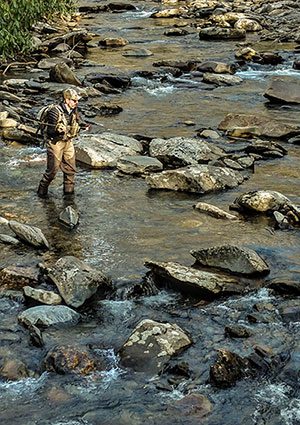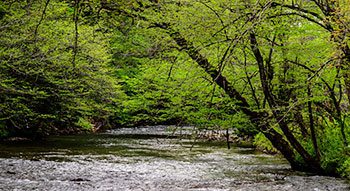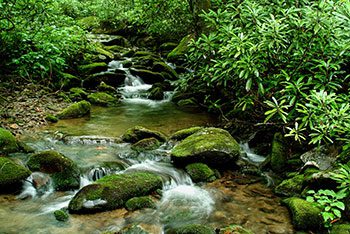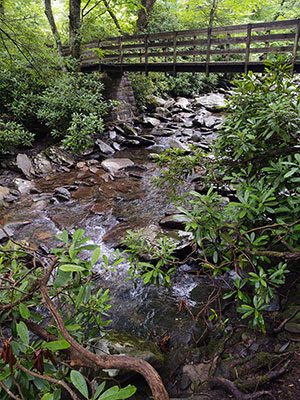
By Mike Kesselring
Fly-fishing. What does it mean to you? When I first heard the term, I pictured somebody trying to put an itty-bitty housefly on a hook. Boy, was I way off. Or was I?
The word “fly,” as used by trout fly fishermen, can mean anything from a nearly invisible midge to an inch long hopper or a three-inch streamer meant to look like a small fish. Most flies used by fly-fishermen mimic the different stages of an aquatic insect’s life cycle. Among them are wet flies tied as nymphs, pupae and larvae and are fished below the surface. Dry flies float on top of the water, imitating three other stages; emergers, adults, and spinners. To better understand trout food and their imitations, brushing up on a little entomology is always a plus.
Mayflies, Caddis flies and Stoneflies are the three most imitated flying insects that fish eat. They don’t look like a housefly, but they do fly. When airborne, the Mayfly resembles a helicopter, the caddis fly, a delta wing jet and the stonefly, a cargo plane. The variety of styles, colors and designs of their imitators are endless. Many are named after their creator, such as Wulff, Adams and Hendrickson.

Names of flies can also describe what they are made of, (Elk Hair Caddis), a stage in an insect’s life cycle, (Parachute Adams), or the variety (Quill Gordon) and color (Blue-Winged Olive) of an insect. Once you become familiar with the names, you learn how they should be used. The list of flies is long, but most fly fishermen rely on as few as six of their favorite and most effective flies.
The endless varieties of flies are simply bits of feathers, fur and thread tied to a tiny hook. Oh, and a spot of glue to keep it all from unwinding. Fly tying is an art.
As you can see, I wasn’t that far off. It is a fly on a hook, but you won’t need a flyswatter or flypaper to harvest your bait.
Fly-fishermen come in as many varieties as the flies they use. From big-city businessmen with the best gear money can buy, to the local good-ole-boy in blue jeans that lives up the holler, to the old-timer who knows all the old-fangled tricks. They all know something the others don’t, so don’t limit yourself to a fishing buddy that’s just like you. You can learn something from everybody. Besides, having a fishing buddy with you when you’re in a beautiful trout stream may save your life some day. The buddy system isn’t just for recreational swimming, especially if you end up swimming downstream after a misstep.

Where can you go fly fishing for trout around here? I prefer the native and wild trout waters of the Great Smoky Mountains National Park. The GSMNP straddles the Tennessee and North Carolina state line with hundreds of miles of fishable waters. The types of creeks in the Park are as varied as the flies and fishermen that end up in those creeks. One unique thing about the Park’s geography is all of its watersheds flow out of the Park giving them some protection in their isolation from invasive species.
I haven’t fished the whole Park yet, but one of my favorite streams on the Tennessee side is the West Prong of the Little Pigeon River. This river parallels Hwy 441 on the Tennessee side of the Park. It starts just below Newfound Gap as Walker Camp Prong. This small creek, where a short 6-7 foot fly rod works best, is home to Native Brook trout locally known as Specks. Walker Camp Prong grows as it tumbles past Alum Cave Creek where it becomes the West Prong of the Little Pigeon River.

As the elevation drops, the river grows bigger and louder. Here’s where an 8-foot rod will work fine for rainbows. As the river falls down the mountainside past Chimney Tops Trail, it tumbles over and around car sized boulders, creating numerous small waterfalls and cascades with ice-cold pools where trout lie in wait for their next meal. Here, the steep mountainsides of the gorge are also the banks of the river.
A couple of miles past Chimney Tops picnic area, the river starts to level out where boulders are much smaller, river is wider, and the banks are at eye level. The last three or four miles before reaching Sugarlands Visitor Center are calmer and more relaxing. A 9’ or 10’ rod works great here for the bigger rainbows and more open water.
Let’s not leave out the North Carolina side. My second favorite river in the park, is the Oconaluftee River. The Oconaluftee also flows down a wide range of elevations, but it is a gentler drop and a wider river.
It, too, parallels Hwy 441, starting out just below Newfound Gap as Beech Flats Prong. Because of the rhododendrons and laurels along its banks, the narrow Beech Flats Prong requires some bushwhacking and a 4’ or 5’ rod. Here you frequently sling shot your fly under the branches to catch Specks waiting for lunch to fall off those same branches.
The Oconaluftee is different from the Little Pigeon with its moss-covered rocks and nice brown trout often caught in it. Well, they aren’t all nice; some of them were kind of grouchy.
These are two of the longest and most accessible streams in the Park. There are hundreds of miles of fishable waters. But I leave them to you to discover on your own, especially the high elevation bluelines not so easily reached.
Two of the best things about fly-fishing is watching a trout break the surface to grab your fly and wading down the middle of nature’s highway. If you take a camera, don’t forget to shoot a picture or two and not just of your fish. That is, if you can stop fishing long enough.
Note: A Tennessee or North Carolina fishing license is required to fish in the GSMNP. Either license is valid and reciprocated on the NC and TN sides of the Park.
Mike Kesselring is a professional photographer, writer, fly collector and a long time GSMNP volunteer. He lives in Bryson City, NC and Walland, TN.